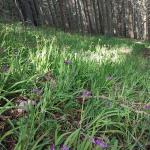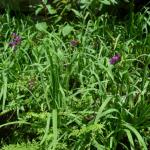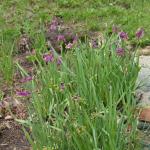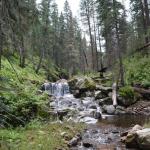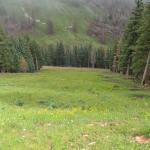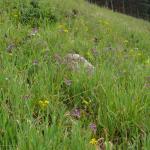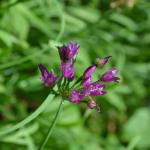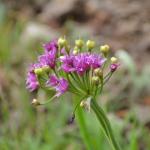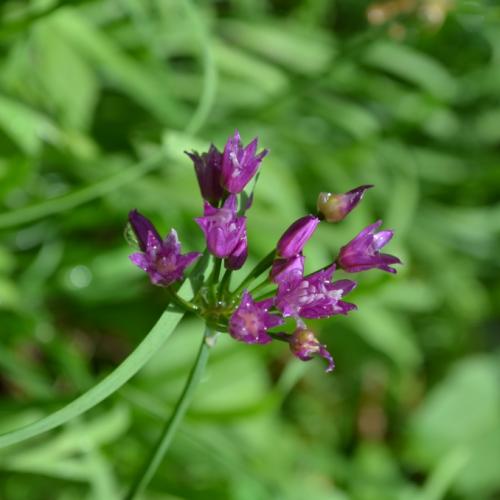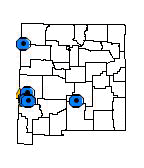Allium gooddingii (Goodding's Onion)
| USFWS | State of NM | USFS | BLM | Navajo Nation | State Rank | Global Rank | R-E-D Code | NMRPTC Status | Strategy Status |
|---|---|---|---|---|---|---|---|---|---|
| E | SEN | GP 3 | S2 | G2 | 2-2-1 | R | SS |
| Overall Conservation Status | Documented Threats | Actions Needed |
|---|---|---|
| WEAKLY CONSERVED | Fire & fire suppression |
Inventory and monitoring. Protect intact, unburned populations. Monitor burned populations for post-fire persistence |
Herbaceous perennial with 1-3 elongate bulbs terminating in a thick, iris-like rhizome; outer bulb coats veined with parallel, not net-like, persistent fibers; leaves obtuse, flat, strap-like 12-30 cm long, 8mm wide; flower stalk erect, longer than the leaves, up to 45 cm long; umbel persistent, erect, loose, 18-23-flowered; tepals erect, purplish-pink; flowers campanulate, 8-10 mm; pedicel 15-20 mm, elongating in fruit. Flowers from late June to early September.
Allium gooddingii is distinguished from other New Mexico Alliums by its broad, strap shaped leaves and its bulb coat of persistent parallel fibers. Two other Alliums may occur in the same habitats as A. gooddingii. Allium geyeri has a similar statue and flowers, but is lighter in color, is not rhizomatus, has bulbs with outer coats that are composed of net-like coarse-meshed fibrous cells, and has a broader habitat range. Allium cernuum has nodding flowers and scaly bulb coats.
New Mexico: McKinley, San Juan, Lincoln and Catron counties; Arizona: Greenlee and Pima counties.
The majority of plants occur at the base of steep slopes and moist drainage bottoms in the shade of spruce-fir and mixed conifer forest and aspen between 6,500 and 9,400 ft. In the Lincoln National Forest Allium gooddingii is found above 10,000 ft in the understory of spruce-fir forests. Some plants persist in areas cleared for ski runs at Ski Apache in the Lincoln National Forest.
Over 95% of all known populations and their habitats burned in seven different wildfires since 2006.
Post-fire study results indicate that the species may survive direct impacts from fire but is unable to maintain itself due to post-fire floods and associated erosion and debris deposition, followed by habitat conversion in response to high intensity fires resulting in canopy removal. A Candidate Conservation Agreement between the USFWS and the USDA Forest Service was never implemented. Therefore little data is available about the status of the species prior to the fires. Other threats include climate change, logging, post-fire restoration activities, ski-run development, and potentially grazing.
*USDI Fish & Wildlife Service and USDA Forest Service, Southwest Region. 1997. Goodding's Onion (Allium gooddingii); Conservation Assessment and Strategy.
Roth, D. 2016. Wildfire Impacts on Species of Concern Plants in the Gila National Forest, New Mexico. Unpublished report prepared by EMNRD-Forestry Division, Santa Fe, NM for the U.S. Fish & Wildlife Service, Region 2, Albuquerque, NM. 48 pp. http://www.emnrd.state.nm.us/SFD/ForestMgt/endangeredandrareplantreports.html
Roth, D. 2016. Wildfire Impacts on Species of Concern Plants in the Lincoln National Forest, New Mexico. Unpublished report prepared by the EMNRD-Forestry Division, Santa Fe, NM for the U.S. Fish & Wildlife Service, Region 2, Albuquerque, NM. 28 pp. http://www.emnrd.state.nm.us/SFD/ForestMgt/endangeredandrareplantreports.html
Roth, D. 2020. Status report. Goodding's onion (Allium gooddingii). Gila and Lincoln National Forest, NM. Unpublished report prepared by the EMNRD-Forestry Division, Santa Fe, NM for the U.S. Fish & Wildlife Service, Region 2, Albuquerque, NM. http://www.emnrd.state.nm.us/SFD/ForestMgt/endangeredandrareplantreports.html
For distribution maps and more information, visit Natural Heritage New Mexico

